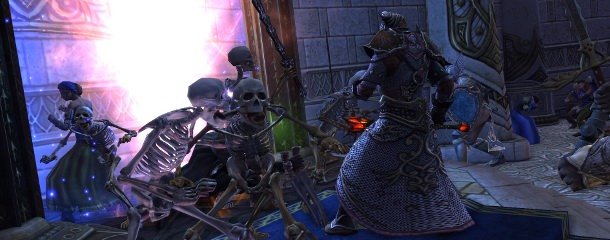
It was this epic memorable thing. And that lesson really stuck with us, and we've kind of taken that to heart as we go forward and develop new layers and new types of dynamic content engagement, whether it's the Onslaughts, where they're all about this building and defensive gameplay for level 50s. And we're doing even crazier stuff in the future.
PCG: How do you keep these elements from becoming old-hat for experienced players?
Hartsman: For us, our big challenge is that people wanted more of those types of experience on their own schedules. The great thing is that they're unpredictable, but the downside is that if you're logging on, you've only got a half hour, if they're unpredictiable you might not get to play the fun. And so that's really what led us to the Onslaught-style development, where the system began to understand, or we taught it, that as players join up these instant advantures and get grouped together, the system will queue up different adventures for them that are appropriate for the number of players in their group. So when we first released the instant adventures, one of the first ones I got in was a give man raid. You know, it was kind of sedate. Fun, but it was more like a popcorn adventure.
Then as more people started going in, we suddenly had to defend a town in Stillmore, was the adventure we were given, and the invaders kept flooding in from all sides, and it really did have that same kind of vibe that we liked from when we first launched the game. So like I said, our big challenge has been how did you created that dynamic excitement while still making it available to someone who might only have 15 minutes to play? That's really where our focus has been these days.
People love grouping in general. What people don't like, though, is they don't want to be the person to initiate and assemble a group, and they also don't want to Be That Guy and feel guilty about dropping out if they have to go. So instant adventure was our way of giving people the fun of grouping while removing those two barriers.
PCG: So how does it work?
Hartsman: When you click on Instant Adventure, you can be given an adventure as a solo person until more people show up, and you just progress that way. And you never have to worry about dropping out because the adventures people are given are going to be suited for the number of people that happen to be there.
Keep up to date with the most important stories and the best deals, as picked by the PC Gamer team.
It was the fun of grouping without the guilt of grouping and without the pain in the ass of grouping.
PCG: It must be tough to balance for these unpredictable groupings.
Hartsman: One of the techniques we use is we don't do anything that is fully machine-generated. Everything is created by designers and is balanced by designers and the scaling is authored by designers.
While it is machine assisted, it is not 100 percent procedurally generated, because doing anything fully procedurally generated would make things even more difficult. I mean, the assignment these designers and engineers have is pretty insane. When we tell them, "You've got this dynamic content. By the way, it needs to be fun if there's five people there or seven hundred people there," because both are very regular cases with our content.
PCG: Anything on the whiteboard that you can tell us about?
Hartsman: One of the prototypes that has been being worked on for the last few months, we haven't really talked about it much at all, is - "What does the next generation of dynamic world-based PvP look like?" We've got the crossyard PvP prototype that we've been working on. And those are really the two big things that we hope to have more info on in the coming months.
PCG: So what are you looking at doing in your second year?
Hartsman: The big stuff for us is what's next. We know this system, we love this system, our players love this system. What we're really focused on is how can we jump ahead even farther. And that's really what this year is about for us.

